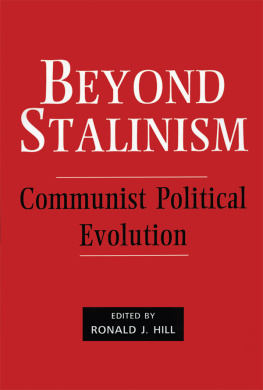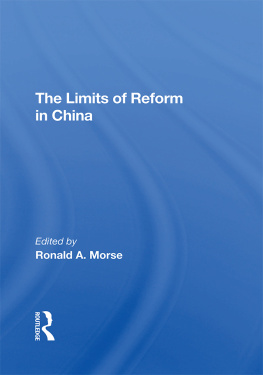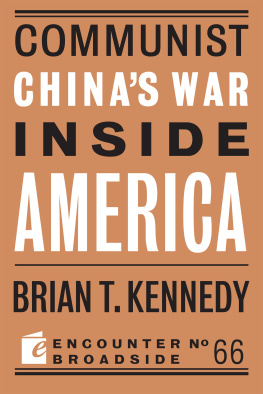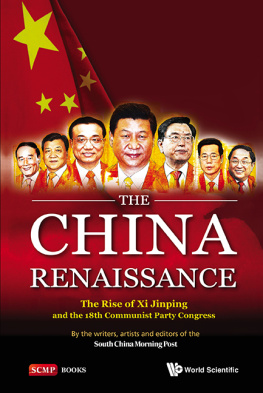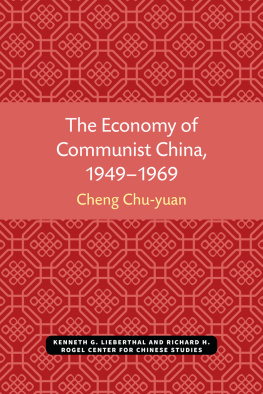Ronald S. Suleski - Early Communist China: Two Studies
Here you can read online Ronald S. Suleski - Early Communist China: Two Studies full text of the book (entire story) in english for free. Download pdf and epub, get meaning, cover and reviews about this ebook. year: 2020, publisher: Kenneth G. Lieberthal and Richard H. Rogel Center for Chinese Studies, genre: Romance novel. Description of the work, (preface) as well as reviews are available. Best literature library LitArk.com created for fans of good reading and offers a wide selection of genres:
Romance novel
Science fiction
Adventure
Detective
Science
History
Home and family
Prose
Art
Politics
Computer
Non-fiction
Religion
Business
Children
Humor
Choose a favorite category and find really read worthwhile books. Enjoy immersion in the world of imagination, feel the emotions of the characters or learn something new for yourself, make an fascinating discovery.
- Book:Early Communist China: Two Studies
- Author:
- Publisher:Kenneth G. Lieberthal and Richard H. Rogel Center for Chinese Studies
- Genre:
- Year:2020
- Rating:3 / 5
- Favourites:Add to favourites
- Your mark:
- 60
- 1
- 2
- 3
- 4
- 5
Early Communist China: Two Studies: summary, description and annotation
We offer to read an annotation, description, summary or preface (depends on what the author of the book "Early Communist China: Two Studies" wrote himself). If you haven't found the necessary information about the book — write in the comments, we will try to find it.
Early Communist China: Two Studies — read online for free the complete book (whole text) full work
Below is the text of the book, divided by pages. System saving the place of the last page read, allows you to conveniently read the book "Early Communist China: Two Studies" online for free, without having to search again every time where you left off. Put a bookmark, and you can go to the page where you finished reading at any time.
Font size:
Interval:
Bookmark:

THE UNIVERSITY OF MICHIGAN
CENTER FOR CHINESE STUDIES
MICHIGAN PAPERS IN CHINESE STUDIES
Chang Chun-shu, James Crump, and
Rhoads Murphey, Editors
Ann Arbor, Michigan
Early Communist China: Two Studies
The Fu-t'ien Incident, December 1930
by Ronald S. Suleski
Agrarian Reform in Kwangtung, 1950-1953
by Daniel H. Bays
Michigan Papers in Chinese Studies
No. 4
1969
Open access edition funded by the National Endowment for the Humanities/Andrew W. Mellon Foundation Humanities Open Book Program.
Copyright 1968
by
Center for Chinese Studies
The University of Michigan
Ann Arbor, Michigan 48104
Printed in the United States of America
ISBN 978-0-89264-004-1 (paper)
ISBN 978-0-472-12819-8 (ebook)
ISBN 978-0-472-90219-4 (open access)
The text of this book is licensed under a Creative Commons Attribution-NonCommercial-NoDerivatives 4.0 International License: https://creativecommons.org/licenses/by-nc-nd/4.0/
Conte nts
by Ronald S. Suleski
Maps :
by Daniel H. Bays
Ronald Suleski
The widening schism between Mao Tse-tung in Kiangsi and the Central Committee in Shanghai was clearly evident in 1930. Mao grew ever stronger in his conviction that a stable, secure guerrilla base was an absolute necessity if the communist movement in China was to succeed. He argued for an extensive organization of guerrillas, composed of loyal peasants, which would eventually expand to engulf the cities. Slowly he began building up his personal power and more determinedly defended his thesis.
Opposition from the Central Committee, then controlled by Li Li-san, likewise mounted. Li Li-san's official directives called for concentrated Red Army strength to attack key cities in central China, and further to precipitate a revolutionary situation by encouraging political strikes and local uprisings. In April, after Li had made his disapproval of Mao's policies clear, Mao was instructed to attend a conference in Shanghai. Li Li-san's probable plan, as Mao must have realized, was to reorganize the leadership within the Kiangsi Soviet, to censure Mao for his refusal to implement fully Central Committee directives, and possibly to attempt to remove him from the Soviet areas entirely. Without any sort of official reply, Mao ignored the summons and instead remained in the forested hills of central Kiangsi.
Initially neither Mao Tse-tung nor Chu Teh were willing to repudiate Central Committee orders openly. Mao realized that, given enough time, it would be possible for him quietly to assume complete leadership of the movement in Kiangsi and insure that Red Army units were under the firm control of trusted subordinates. Because of the Central Committee's insistence that armed attacks on key cities be launched immediately, however, Mao was denied the time needed to centralize his power within the relative safety of Kiangsi. Major attacks on Nanch'ang and Ch'angsha, ordered by the Central Committee, were launched by Mao and Chu Teh in July 1930. But the Red armies, as Mao had predicted, were unable to hold the cities or to spark revolutionary support from the populace. These failures decided Mao's future course of action. Openly opposing the Central Committee, Mao and Chu Teh called off the attacks and shortly thereafter Mao began moving to eliminate political rivals within the Kiangsi Soviet.
It is in the context of these failures that the Fu-t'ien incident can best be understood. The events after September 1930 represent Mao's first dramatic steps to gain control over the Chinese communist movement, although at that time his goal was limited to Kiangsi and there is no evidence that he was hoping to get supreme authority over the entire movement. Actions taken to face the crises of the following seven months were certainly under the direct control of Mao, thus providing an example of the methods employed by Mao when not confined by directives from a higher authority.
To exercise his control over the civilian governmental structure, Mao was able to work through the General Front Committee, a legitimate organization whose membership was composed largely of pro-Mao communists. Serious opposition to Mao's leadership was presented by the Kiangsi Provincial Action Committee, which had been organized in the Soviet areas by Li Li-san to counteract the pro-Mao Front Committee.
The entire Fu-t'ien incident and its aftermath centers most strongly around Mao's efforts to remove the Action Committee from power and the Action Committee's continued support for official policies of the Central Committee. Mao was successful in removing the Action Committee from leadership, but factors beyond his control (chiefly the KMT encirclement campaigns and the Central Committee's move from Shanghai to Kiangsi) were responsible for delaying his accession to complete control of the Chinese communist movement.
With the bulk of the Red Army back inside the Soviet regions after their unsuccessful efforts to hold Nanch'ang and Ch'angsha, Mao was able to take the market town of Kian. Built on the banks of the Kan River, Kian would serve as an excellent administrative center for the areas Mao hoped to consolidate.
Shortly after the occupation of the town, documents concerning activities of the notorious Anti-Bolshevik (AB) Corps were discovered by the Red Army. Supposedly organized by and receiving funds from the KMT, AB Corps members operated as spies within communist organizations, collecting strategic information and sending it up through secret AB Corps channels, or organizing dissatisfied communists to perform disruptive functions within the Soviet areas. It was possibly known that the Corps was active in the area, but the extent of its penetration into communist organizations had not been discovered until the documents were found.
The captured documents revealed, after the KMT code had been broken, that five high-level CCP members, some of them Red Army commanders, had connections with the AB Corps. Instead of immediate arrests, Mao and Chu Teh decided to initiate an investigation that might eventually uncover the entire organization and expose its membership.
Shortly thereafter, while the Soviet government was still establishing itself in the city, it was decided at a conference held by the General Front Committee that Kian must be evacuated. Increasing numbers of KMT troops were headed toward Kiangsi to attack the Soviet areas and Kian was likely to be a target of their attacks. The Front Committee resolved to adopt the strategy, developed by Mao and Chu Teh, of luring the enemy to penetrate deeply into the Soviets, where small communist guerilla units would have the advantage over KMT divisions. The first step would be to lure the enemy into the Kian area. Members of the Provincial Action Committee, who had already located themselves in Kian, were informed of the decision and instructed to move their organizations from the city.
Some Action Committee opposition to the evacuation probably followed. The Committee favored Li Li-san's policies, which called for attacks on major cities, so they could hardly agree with voluntarily surrendering Kian. In addition, they saw the city's potential as a base for developing their power and disseminating propaganda. But the Committee could not defend the city alone, and during the first weeks of November, possibly after having resisted the move for a few days, they moved to the town of Fu-t'ien and Kian was retaken by the KMT.
We might expect that after the evacuation, while the Soviet government was relocating itself, the investigation into AB Corps activity continued. In late November, possibly because the investigation had been completed, Mao ordered mass arrests of suspected AB Corps members. Perhaps more than 4,000 officers and men of the 20th Army, including the political commissar, Hsieh Han-ch'ang, were arrested. These arrests, carried out in the Huang-p'o district of Yung-feng county, became known as the Huang-p'o incident.
Font size:
Interval:
Bookmark:
Similar books «Early Communist China: Two Studies»
Look at similar books to Early Communist China: Two Studies. We have selected literature similar in name and meaning in the hope of providing readers with more options to find new, interesting, not yet read works.
Discussion, reviews of the book Early Communist China: Two Studies and just readers' own opinions. Leave your comments, write what you think about the work, its meaning or the main characters. Specify what exactly you liked and what you didn't like, and why you think so.



